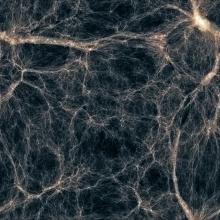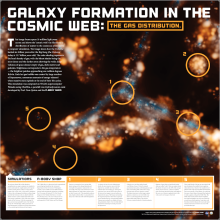The N-Body Shop is a UW-based research group with the goal of pursuing world class research in the field of theoretical and computational astrophysics. We focus on the formation and evolution of planetary systems and cosmic structures, from dwarf galaxies to clusters. Strong emphasis is given to the physical interpretation of numerical simulations results and an ‘apple to apples’ comparison of simulations with observations from different observing groups.
In a nutshell, an n-body simulation calculates the time and spatial evolution of a system modeled by a large number of mass elements and subject to many different physical processes — such as gravity, hydrodynamical forces, gas cooling, star formation and energy injection from supernovae and black holes. N-Body Shop students are able to pursue different aspects of this broad approach: developing theoretical models, computer science, analysis of simulations, and outreach.
Over the years we have developed two of the best parallel tree and smooth particle hydrodynamics (SPH) codes: GASOLINE and, its evolution, CHaNGa. Our focused approach on developing a small set of versatile computational and analysis tools allows our relatively small group to pursue competitive research spanning a wide range in spatial and time scales. Please visit our GitHub organization for access to our software tools.
The Group
The current N-Body members include Professors Rory Barnes, Thomas Quinn, and several long term international collaborators: Dr. Jillian Bellovary* (AMNH), Prof. Alyson Brooks* (Rutgers U.), Prof. Charlotte Christensen* (Grinnell), Prof. J. Wadsley* (MacMaster University), professors George Lake*, Lucio Mayer* and Benjamin Moore* (University of Zurich), and Prof. Andrew Pontzen (UCL, UK). Prof. Lake is also the original founder of the N-Body Shop!
*People marked with an asterisk were previous UW faculty, grad students, or post-docs.
Grad and Undergrad Students:
We strive to promote a welcoming environment for people of all genders, faiths and sexual orientations. The N-Body Shop has mentored several students over the years, often in collaboration with other UW faculties. Most of our alumni are still in the science field, both in academia or the private sector. Please write to any current N-Body Shop member if you are interested in working with us or in pursing a degree at the UW Astronomy Department!
Outreach
By providing interesting research projects, the N-Body Shop participates in Pre-Map, a UW Astronomy department initiative. Pre-Map introduces undergrad students to astronomical research early in their college careers. By providing them with academic advising and one-on-one mentorship through their first year, Pre-MAP aims to give underrepresented students the motivation and tools to succeed in our field. Our grad students also regularly participate in Astronomy on Tap, a series of national public events that feature accessible, engaging science presentations on topics ranging from planets to black holes to the beginning of the Universe.
Future and ongoing work
We are focusing on the formation and growth of supermassive black holes (2017 graduate Michael Tremmel), the reionization of the Universe by small dwarf galaxies (2016 graduate Lauren Anderson), the effects of non standard Dark Matter on the observable properties of galaxies (2015 graduate Alexander Fry) and the formation of giant planets (2017 graduate Isaac Backus) and circumbinary planets (2020 graduate David Fleming).
Science Highlights
The N-Body Shop has focused on a relatively small, but very high impact set of publications on various topics close to our core interests. Here is a selection of our best hits.
- 1996 Nature “Galaxy harassment and the evolution of clusters of galaxies“
- 1998 ApJ “Dark Matter Substructure within Galactic Halos“
- 1998 Nature “The seeds of rich galaxy clusters in the Universe“
- 2002 Science “Formation of Giant Planets by Fragmentation of Proto planetary Disks“
- 2010 Nature “Bulgeless dwarf galaxies and dark matter cores from supernova-driven outflows“
- 2012 Nature “CDM heats up“
- 2015 CAC "Adaptive techniques for clustered N-body cosmological simulations"
Media/Videos
A fly by around the Dark Matter halo of a Milky Way like galaxy.
The color map shows the metallicity of gas (red metal rich, blue metal poor) as it is enriched by supernova winds. (frame: 150kpc)
N-body cosmological simulation. The color map shows the gas temperature (red=hot, blue=cold) of a forming Milky Way like galaxies (frame: 150kpc). Blue and magenta are young and old stars respectively. White dots represent the Super Massive Black Holes formed in the simulation.
A scan through a multi billion particles cosmological simulation seen at redshift = 2.
Blue: cold gas. Red: hot gas. The frame is 25 comoving Mpc across.
A hydrodynamical simulation of the formation of planetary system.


